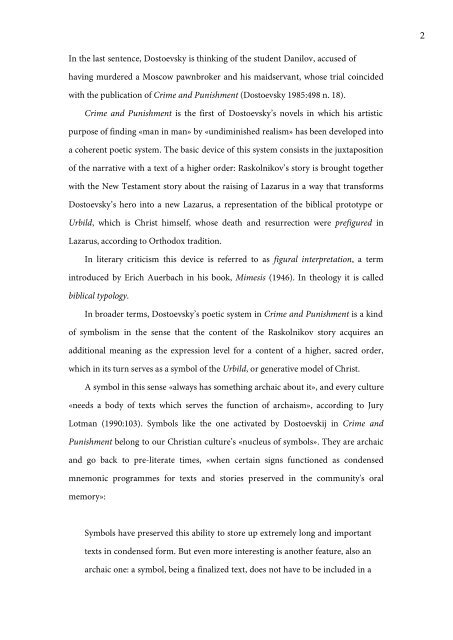Jostein Børtnes Dostoevsky's Idiot or the Poetics of Emptiness1 ...
Jostein Børtnes Dostoevsky's Idiot or the Poetics of Emptiness1 ...
Jostein Børtnes Dostoevsky's Idiot or the Poetics of Emptiness1 ...
Create successful ePaper yourself
Turn your PDF publications into a flip-book with our unique Google optimized e-Paper software.
In <strong>the</strong> last sentence, Dostoevsky is thinking <strong>of</strong> <strong>the</strong> student Danilov, accused <strong>of</strong><br />
having murdered a Moscow pawnbroker and his maidservant, whose trial coincided<br />
with <strong>the</strong> publication <strong>of</strong> Crime and Punishment (Dostoevsky 1985:498 n. 18).<br />
Crime and Punishment is <strong>the</strong> first <strong>of</strong> Dostoevsky’s novels in which his artistic<br />
purpose <strong>of</strong> finding «man in man» by «undiminished realism» has been developed into<br />
a coherent poetic system. The basic device <strong>of</strong> this system consists in <strong>the</strong> juxtaposition<br />
<strong>of</strong> <strong>the</strong> narrative with a text <strong>of</strong> a higher <strong>or</strong>der: Raskolnikov’s st<strong>or</strong>y is brought toge<strong>the</strong>r<br />
with <strong>the</strong> New Testament st<strong>or</strong>y about <strong>the</strong> raising <strong>of</strong> Lazarus in a way that transf<strong>or</strong>ms<br />
Dostoevsky’s hero into a new Lazarus, a representation <strong>of</strong> <strong>the</strong> biblical prototype <strong>or</strong><br />
Urbild, which is Christ himself, whose death and resurrection were prefigured in<br />
Lazarus, acc<strong>or</strong>ding to Orthodox tradition.<br />
In literary criticism this device is referred to as figural interpretation, a term<br />
introduced by Erich Auerbach in his book, Mimesis (1946). In <strong>the</strong>ology it is called<br />
biblical typology.<br />
In broader terms, Dostoevsky’s poetic system in Crime and Punishment is a kind<br />
<strong>of</strong> symbolism in <strong>the</strong> sense that <strong>the</strong> content <strong>of</strong> <strong>the</strong> Raskolnikov st<strong>or</strong>y acquires an<br />
additional meaning as <strong>the</strong> expression level f<strong>or</strong> a content <strong>of</strong> a higher, sacred <strong>or</strong>der,<br />
which in its turn serves as a symbol <strong>of</strong> <strong>the</strong> Urbild, <strong>or</strong> generative model <strong>of</strong> Christ.<br />
A symbol in this sense «always has something archaic about it», and every culture<br />
«needs a body <strong>of</strong> texts which serves <strong>the</strong> function <strong>of</strong> archaism», acc<strong>or</strong>ding to Jury<br />
Lotman (1990:103). Symbols like <strong>the</strong> one activated by Dostoevskij in Crime and<br />
Punishment belong to our Christian culture’s «nucleus <strong>of</strong> symbols». They are archaic<br />
and go back to pre-literate times, «when certain signs functioned as condensed<br />
mnemonic programmes f<strong>or</strong> texts and st<strong>or</strong>ies preserved in <strong>the</strong> community's <strong>or</strong>al<br />
mem<strong>or</strong>y»:<br />
Symbols have preserved this ability to st<strong>or</strong>e up extremely long and imp<strong>or</strong>tant<br />
texts in condensed f<strong>or</strong>m. But even m<strong>or</strong>e interesting is ano<strong>the</strong>r feature, also an<br />
archaic one: a symbol, being a finalized text, does not have to be included in a<br />
2

















